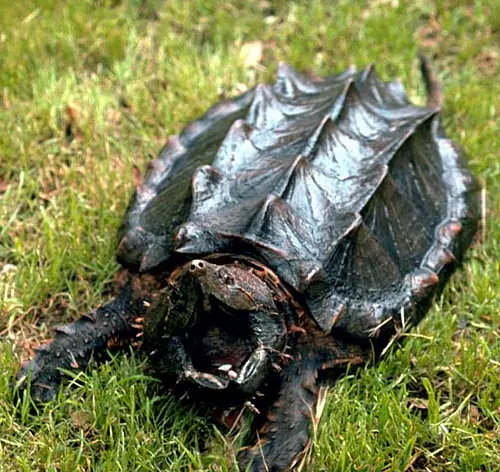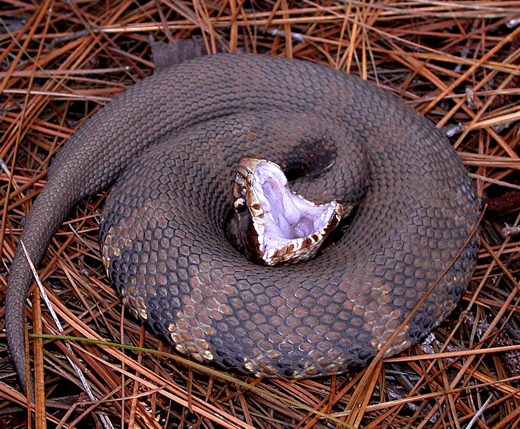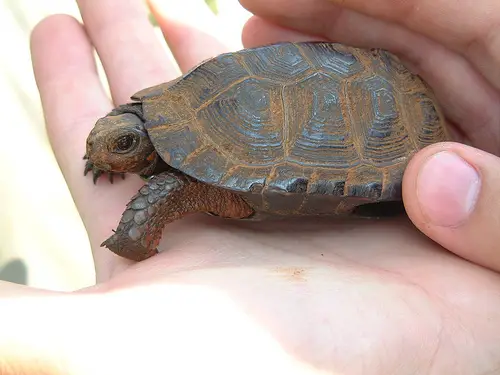Alligator Snapping Turtle
The Alligator snapping turtle is the largest turtle that lives in fresh water in North America, and is also one of the largest turtles in the world.
Looking for all the world like a prehistoric sea monster, it boasts a spiked shell, a jaw that reminds you of a birds beak, thick scaly tale and if you didn’t know better you would believe you were looking at a dinosaur.

The Alligator Snapping turtle looks quite prehistoric
In fact, the Alligator Snapping Turtle is nicknamed the Dinosaur of the turtle world.
You will find Alligator snapping turtles nearly always in rivers, canals and lakes, particularly in the Southern part of the United states, mostly the eastern side, they can and have lived to be nearly 100 years old.
The males average about 2 and a half feet in shell length, and usually weigh about 150-175 although they have been known to grow to weigh more than 225 pounds.
The females are much smaller, usually weighing only about 50 pounds.
Most of their lives are spent in the water, with egg laying being the exception.
When she has mated in springtime, the female will emerge from the water and trudge inland about 50 yards until she finds a place that is suitable for nesting and dig, whereupon she will deposit 25-35 eggs and bury them.
Alligator snapping turtles then return to water and remain there until time to mate again. They are well suited for the water life, and can stay submerged below the water for upwards of 45 minutes before rising to the top for air.
Alligator snapping turtles use a unique means of hunting for their prey. They have a built in lure to bring the prey to them.
They have a tongue that is worm shaped, and very bright red. When lying without any movement on the bottom of a river or lake, they will flick the tongue and draw in curious fish or frogs to see what manner or worm or food this is, at which time they snatch the prey from the water.
As adults, the Alligator snapper has no real natural predator aside from human beings, who often take them for the meat (to make turtle soup) and the shell for adornments. They are also sold at times to exotic animal collectors.
They are stable but because of unregulated harvesting and sales of the Alligator snapper, and habitat loss due to humans encroachment on their turf, they are protected in most states, and in nearly all areas where they live or range.



how many are left in the world???????????????
Im from Fargo,ND. there are many snappers like that around the red river area. they could not be that endangered because i have seen quite a bit of them. sometimes you step onthem and think its just a rock, untill you hear there hissing noise they make and hope you dont loose a toe. lol, hope this information helped a bit
No you don’t. You have common snapping turtles there.
you need more fact about the snapping turtle such as how are they protected .
That Turtle Is Awsome
wow what the heck it looks weird how many are left when did u find it?
Do snappers have spikes on the back of there shells?
Quite a few saw about 50 in the marsh behind my house
Hi Lotor,
What town, state do you live in???? We have quite a few in our pond but no idea exactly how many (they all kind of look alike!) Did witness two in a fight in the water last year and that truly looked like something out of Jurassic Park!!
Threatened but tends not to be rare in locations left for them
snapping alliogator turtle awwwwwwwwwwwwwwwwwwwwwwwww :0
Snapping Turtles are the scariest, and the coolest animal in the whole world (not including the African Lion). *.*
I HAVE TWO BABY ALLIGATOR SNAPPING TURTLE
you are crazt
are these snapping turtles endangered or listed by IUCN ??
I wish I was camera ready when I came across the most unusual creature I had ever seen and a magnificent gigantic specimen!
While driving down a dirt road up in Central WI area; about
40 minutes North of the popular WI Dells area and around the Wautoma area; came across this huge and I mean huge alligator turtle! I had never seen an alligator turtle before though I had seen snapping turtles which bare some resemblance but its kind of like saying the squirrel monkey resembles King Kong!
This thing had a huge alligator tail, not just this little skinny tail in these pictures I have seen online. So far I have seen no pics to come close to the one I saw! The tail itself that started out of the back of the shell was easily about 1.5 feet width across gradually tapering to a width of
maybe a foot in width within a foot length and from there gradually tapering to 3.4 foot another cpl feet until it tapered off at the end! It was probably over 4 feet long
and that was just the tail! The shell portion in itself was
also huge about 4 feet length by about 3 feet wide across the top and not counting circumference! It was all black and prehistoric looking and was dragging across the road as our truck sped forward. I wanted to jump out, but the driver wanted to just avert hitting it and kept going. I got the driver to turn back, but by then there were no signs of it as it had crossed the road and was completely out of sight in the tall grass and natural weeds etc. I wouldnt have a clue how to get hold of the thing anyway because the head was huge
and they apparently have a grasp that locks and then the tail
like an alligator tail could probably wallop you good too and
the shell you could not hardly grab hold of with all those spikes either!!! I wish I had a pic of that alligator turtle!
I dont think people hardly believe it but I am at least glad to see online they list there is such a creature and they do grow huge!
that turtle is the most screwed up turtle ever!